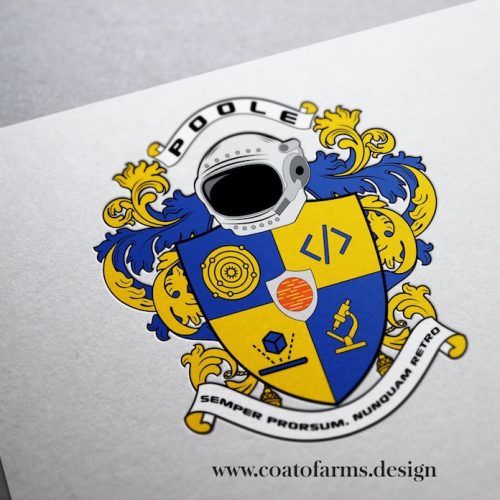Coat of arms I designed for a book telling a story about an imaginary kingdom.
* Heraldry, the science and the art that deal with the use, display, and regulation of hereditary symbols employed to distinguish individuals, armies, institutions, and corporations. Those symbols, which originated as identification devices on flags and shields, are called armorial bearings. Strictly defined, heraldry denotes that which pertains to the office and duty of a herald; that part of his work dealing with armorial bearings is properly termed armory. But in general usage heraldry has come to mean the same as armory. The initial meaning of the term herald is disputed, but the preferred derivation is from the Anglo-Saxon here (“army”) and wald (“strength” or “sway”).
In the second half of the 12th century the men who supervised festivities and delivered invitations to guests were often the same minstrels who, after tournaments and battles, extolled the virtues and deeds of the victors. Heralds can be identified in the descriptions of tournaments from about 1170. The duties of minstrels and messengers appear then to have merged, and, as the minstrels recounted the deeds and virtues of their masters and their masters’ ancestors, their interest in genealogy developed. That new skill was related to their tournament duties, which included the necessity to recognize the banners and shields of all those invited to attend. As heraldry developed its elaborate technical language and as armorial display expanded in subsequent centuries, so the importance and consequent status of heralds grew.
MORE WORK

Church seal I designed for the Polish Church in Los Angeles, USA
digital painting technique
My last business Coat of Arms project for the Royal Palace Hotel
digital painting technique
Coat of arms (family emblem) I designed for a German traders family from Berlin with an archer in the crest
digital painting technique
Business logo coat of arms for a Royal Golf Club from the USA
digital painting technique
My reconstruction of the Paffrath family coat of arms from Germany, which was created in the year 1402.
vector painting technique
Coat of arms for the Santa Maria oceanic yacht club from the USA
digital painting technique
Coat of arms (crest logo) I have designed for a Golden Horse stable form the USA
digital painting technique
Coat of arms I designed for the novel writer from the USA
digital painting technique
Yet another ecclesiastical coat of arms for the Christian family from the USA
digital painting technique
Proposition of the ecclesiastical coat of arms
digital painting technique
Family crest I designed for the Vanhinberg family from Germany
digital painting technique

Coat of arms I designed for a British rock band Wishbone Ash for their 50th anniversary album
digital painting technique
Coat of arms I designed for a software developer and his family from the USA
vector painting technique

Logo project for a Security Company from Kuwait
digital painting technique

Family crest I designed for a Platten family from the UK
vector painting technique
Coat of arms I designed for a PhD and a professional linguist from Australia
digital painting technique
A coat of arms I designed for a Kabuto Kingdom micronation
digital painting technique
Fictional coat of arms I designed for a historical romance author
vector painting technique
A family crest I designed for Stafford family from the USA
vector painting technique

Coat of arms (family crest) I designed for an attorney family from Austria
digital painting technique



